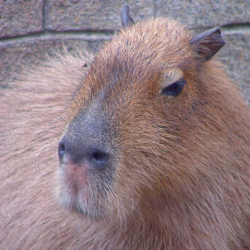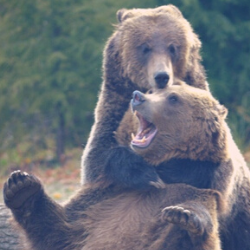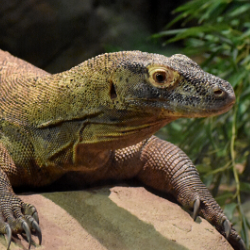After all the mushy sentiment of the lovebirds on Valentine’s Day, it is nice to know we still have Singles Awareness Day to celebrate flying solo! Each year on February 15th, we declare to the world that there is nothing wrong with being single.
There are several advantages to being unattached, including the ability to choose when to eat, when to sleep, where to go and what to do with your life. Much in the same way, some animals prefer the single life, either by nature or just because of their personalities. Check out a few of our animals below, whose singleness you should be aware of!
Atlantis
 You may know Atlantis as the Akron Zoo’s one and only capybara! Generally speaking, capybaras are social animals who live in family packs of several dozen individuals. They are also known to be social with other species, allowing smaller animals to ride on their backs! Atlantis, however, is an individual that refuses to be limited by what is “usual” for her species. She has a big personality that leaves very little room for others.
You may know Atlantis as the Akron Zoo’s one and only capybara! Generally speaking, capybaras are social animals who live in family packs of several dozen individuals. They are also known to be social with other species, allowing smaller animals to ride on their backs! Atlantis, however, is an individual that refuses to be limited by what is “usual” for her species. She has a big personality that leaves very little room for others.
In the past, Atlantis was partnered with a male capybara as part of the Capybara Species Survival Plan (SSP). Despite the high hopes of keepers for a blossoming love connection, Atlantis made it clear that she was not willing to share her habitat, and the male was moved to another zoo to spend time with more welcoming company.
Atlantis now spends her time in Legends of the Wild as a strong, independent capy!
Milan
 Milan, our beautiful jaguar, is one of the newest additions to the Akron Zoo family. By nature, jaguars are solitary animals. In their natural habitat, jaguars mark a territory of several square miles by scent marking and clawing trees. The only time a female jaguar like Milan would be found in the company of a male jaguar is during mating season.
Milan, our beautiful jaguar, is one of the newest additions to the Akron Zoo family. By nature, jaguars are solitary animals. In their natural habitat, jaguars mark a territory of several square miles by scent marking and clawing trees. The only time a female jaguar like Milan would be found in the company of a male jaguar is during mating season.
Milan is currently the only jaguar at the Akron Zoo, so a relationship is not in the foreseeable future, but this cat lady (or lady cat?) has certainly enjoyed exploring and claiming all of the new space for herself! She has spent much of her time rearranging the enrichment items in her bachelorette pad, and she is acclimating well.
Milan will remain inside until things outside heat up, but be sure to drop by the zoo to meet her this spring!
Grizzly Bears
 Grizzly bears, like jaguars, tend to be solitary creatures by nature. In their natural habitat, grizzlies only congregate in prime Alaskan fishing locations during salmon spawning season. However, Jackson and Cheyenne grew up together, and they choose to remain that way!
Grizzly bears, like jaguars, tend to be solitary creatures by nature. In their natural habitat, grizzlies only congregate in prime Alaskan fishing locations during salmon spawning season. However, Jackson and Cheyenne grew up together, and they choose to remain that way!
Jackson and Cheyenne’s mother was a grizzly bear who became accustomed to finding food near cities and towns in Wyoming. After repeatedly wandering into city centers, she was humanely euthanized by the US Fish and Wildlife service in 2011. Unfortunately, this was before anyone realized she had two young cubs. Since the cubs were too young to be left to fend for themselves, the Akron Zoo designated a habitat in Grizzly Ridge to be their new home.
Since grizzlies are solitary, the cubs could not be placed with an older bear to learn regular grizzly behavior. Instead, the pair was raised in human care, and they remain a little, close-knit family to this day. The two can often be seen behaving like siblings, roughhousing and playing together in their habitat. They also enjoy swimming, running, participating in training and enrichment sessions, and taking long winter naps!
Tai Lung
 Snow leopards are solitary, elusive animals, and Tai Lung is no exception. Though he and Shanti spend time together during mating season, a majority of Tai Lung’s time is spent on his own.
Snow leopards are solitary, elusive animals, and Tai Lung is no exception. Though he and Shanti spend time together during mating season, a majority of Tai Lung’s time is spent on his own.
In their natural habitat, snow leopards mark their territories by urinating on boulders and trees along the perimeter of their claimed area. They make a high-pitched yowl while they are leaving their scent, though they can also hiss, mew, chuff, growl and wail to attract a mate. When a female has cubs, she cares for them until they are 18-22 months old, when they are old enough to become independent. The cubs usually never meet their father.
In keeping with his elusive nature, Tai Lung enjoys climbing to the highest point in his habitat and using his camouflage skills to disappear into the rocks. He is most vocal during mating season, and guests may see him calling to Shanti from the cliff at the top of his habitat. Since Shanti has been busy raising Baya, she and Tai Lung will not be together again until Baya is old enough to be on her own. Until then, Tai Lung is enjoying the single life!
Komodo Dragons
 Last year on Valentine's Day we highlighted our Komodo dragons for their unusual mating behaviors, but Komodo dragons are actually solitary by nature. Draco and Padar, the two Komodo dragons who call the Akron Zoo home, rotate between habitat spaces, instead of sharing the same areas.
Last year on Valentine's Day we highlighted our Komodo dragons for their unusual mating behaviors, but Komodo dragons are actually solitary by nature. Draco and Padar, the two Komodo dragons who call the Akron Zoo home, rotate between habitat spaces, instead of sharing the same areas.
In their natural habitat, the Komodo dragon is a solitary and powerful predator that roams a territory which depends on an individual's size. During mating season, females actively resist males, so a male must be much larger than the female for successful fertilization. However, female Komodo dragons are also able to reproduce without any involvement from their male counterparts. Depending on environmental conditions, some females can fertilize their own eggs.
Despite nesting and laying eggs, Komodo dragon mothers are hardly motherly. The life of a young Komodo dragon is fraught with danger. Larger Komodo dragons will eat both eggs and smaller individuals of the species, so offspring who successfully hatch often spend their early years in trees, avoiding predation by larger individuals like their parents!
The Akron Zoo does not have a breeding recommendation from the Komodo Dragon SSP, so for now Draco and Padar remain solitary and single. However, Draco has been known to lay (and eat) eggs throughout her habitat!
Sumatran Tigers
 Though the Akron Zoo is not currently home to any of these beautiful big cats, we eagerly anticipate the arrival of two Sumatran tigers later this summer with the opening of Lehner Family Foundation Wild Asia!
Though the Akron Zoo is not currently home to any of these beautiful big cats, we eagerly anticipate the arrival of two Sumatran tigers later this summer with the opening of Lehner Family Foundation Wild Asia!
In their natural habitat, tigers are territorial and solitary in nature. They socialize through visual signals, scent marking and vocalizations, not physical contact. There have been a few documented cases of tigers hunting in groups, much like a pride of lions, though these instances are few and far between.
Like many of the other species highlighted, tigers will come together during breeding season. A male tiger’s territory is usually large enough to overlap several females’ territories, because they value accessibility of females over any other natural resource. Younger, stronger males will often challenge older males for their territories.
All tigers are endangered, including the Sumatran tigers who will call the Akron Zoo home. It's estimated that only 300 Sumatran tigers remain in their natural habitat today. Our plans for two spacious tiger habitats with grassy slopes and a pool will allow the Akron Zoo to contribute to the Tiger SSP by enabling more of these powerful, solitary cats to call the Akron Zoo home. Through our continued participation in the SSP, guests can also look forward to tiger cubs - a joy we've not celebrated in almost two decades. It is our hope to save the Sumatran tiger from extinction, to be loved for generations to come.
